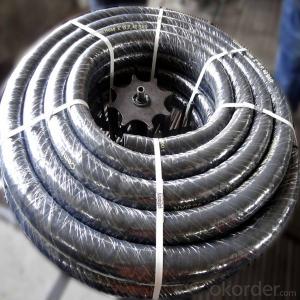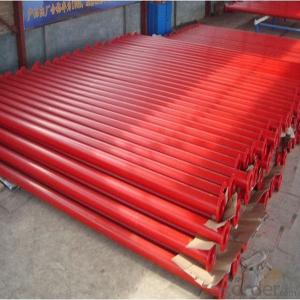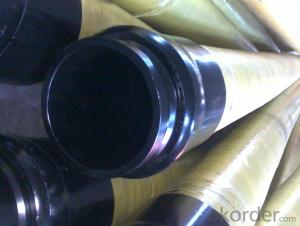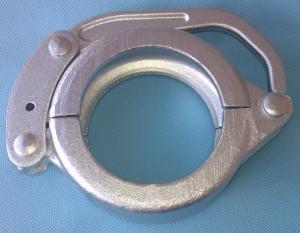Cement Truck Spare Parts Cement Hose 2'' W.P.40BAR
- Loading Port:
- Tianjin
- Payment Terms:
- TT OR LC
- Min Order Qty:
- 100 pc
- Supply Capability:
- 100000 pc/month
OKorder Service Pledge
OKorder Financial Service
You Might Also Like
Product Description:
The Cement Truck Spare Parts Cement Hose 2'' W.P.40BAR normally made by natural rubber, to make sure the quanlity of elbows according to customer’s requests we usually keep the content of NB rubber and concbined fabric layers inside hoses, it will have a longer life as well, package will be rolled and put into container.
Scope of Application of the Goods
The Cement Truck Spare Parts Cement Hose 2'' W.P.40BAR is a concrete pumps parts for combined use with other concrete parts in for coment trucks. It can be widely used in the construction of various types of cement delivery like industrial and civil buildings, bridges, roads, and other types of infrastructure.
This seals can only be used in cement truck on water use, but not in any other operations.
Product Advantages:
OKorder's Cement Truck Spare Parts Cement Hose 2'' W.P.40BAR Channels are durable, strong, and safety.
Main Product Features:
· Premium quality
· Prompt delivery & seaworthy packing (5-10 days)
Reliable performance
Easy to weld
High safety.
· Professional Service
· Competitive pricing
Measuring of wall thickness from the outside
Low purchase cost
Specifications:
DN:2''
Thickness: 6-30mm
Material:Rubber
FAQ:
Q1: How long about delivery time Cement Truck Spare Parts Cement Hose 2'' W.P.40BAR ?
A1: Normally we keep the raw materials for old customers and sometime we also keep stock products to make sure delivery time in any emergency cases.
Q2: How do we guarantee the quality of our Cement Truck Spare Parts Cement Hose 2'' W.P.40BAR?
A2: We have established an advanced quality management system which conducts strict quality tests at every step, from raw materials to the final product. At the same time, we provide extensive follow-up service assurances as required.
Q3: How soon can we receive the product after purchase?
A3: Within three days of placing an order, we will book the vessel for goods. The specific shipping date is dependent upon international and government factors, but is typically 7 to 30 workdays.
Q4: If we can produce some goods according to customers request?
A4: Yes, we can produce Cement Truck Spare Parts Cement Hose 2'' W.P.40BAR according to the difference country situations to make it suitable to the market and customers. We have very professional technical team to make the design for porduction of seals.
Q5: How to make a quick resolution for after service?
A5: OKorder and our manufacture both have overseas branches all-around of world.
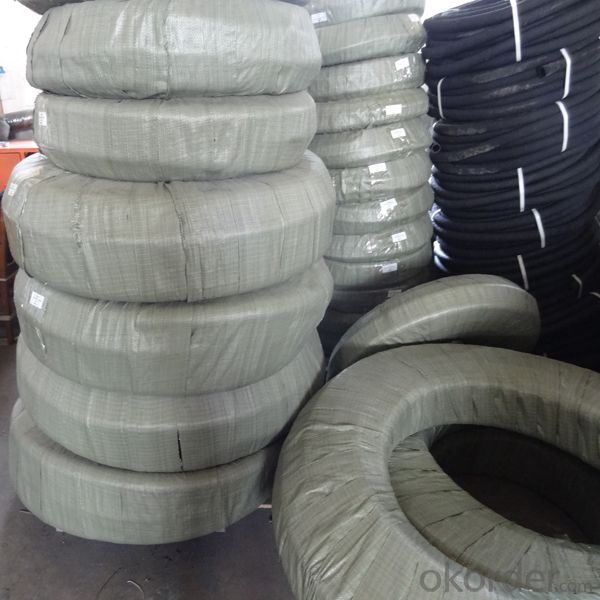
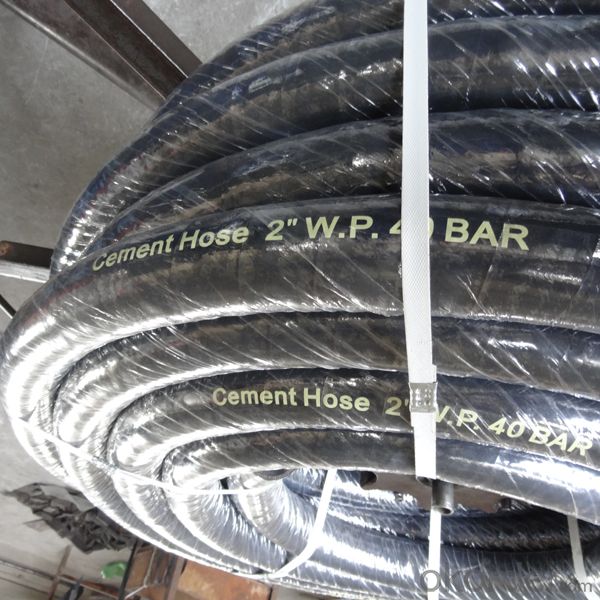
- Q: Are there any safety considerations when using concrete pump spare parts?
- Yes, there are several safety considerations when using concrete pump spare parts. Firstly, it is important to ensure that the spare parts are of high quality and meet the necessary safety standards. Using substandard or faulty spare parts can increase the risk of accidents and malfunctions. Additionally, proper training and knowledge of the equipment and spare parts are crucial to ensure safe operation. Regular inspection and maintenance of the spare parts are also essential to prevent any potential hazards. Lastly, following all safety guidelines and protocols provided by the manufacturer is necessary to minimize the risk of injuries or accidents while using concrete pump spare parts.
- Q: How can one differentiate between genuine and counterfeit concrete pump spare parts?
- Differentiating between genuine and counterfeit concrete pump spare parts can pose a challenge, but there are several methods to ensure the authenticity of your purchase. Consider the following strategies: 1. Manufacturer Research: Begin by thoroughly researching the manufacturer of the concrete pump spare parts. Look for reputable, well-established companies with a proven track record. Analyze their industry standing, read customer reviews, and examine their website. Genuine manufacturers typically have a strong online presence and provide detailed product information. 2. Supplier Verification: When purchasing spare parts, it is crucial to select a reliable and authorized supplier. Ensure the supplier has a good reputation in the industry and a long-standing presence. Authorized distributors often have direct relationships with manufacturers and can provide authentic parts. 3. Inspection of Product Packaging: Genuine concrete pump spare parts typically have specific packaging that includes branding, logos, and detailed product information. Counterfeit products may have inferior packaging quality, misspellings, incorrect logos, or inconsistent color schemes. Carefully examine the packaging to determine its authenticity. 4. Evaluation of Product Quality and Finish: Counterfeit parts are often made from low-quality materials and lack the precision and finish of genuine parts. Inspect the spare parts for signs of poor workmanship, rough edges, or uneven surfaces. Genuine parts are typically well-crafted and undergo strict quality control measures. 5. Price Comparison: Exercise caution when encountering significantly lower prices for spare parts, as this may indicate counterfeit products. Counterfeiters often sell their goods at lower prices to attract customers, but the quality and performance may be compromised. Compare prices with other suppliers to ensure they fall within the expected range. 6. Seek Expert Advice: If you are unsure about the authenticity of concrete pump spare parts, consult industry experts or experienced professionals. They can assist you in identifying genuine components and making informed decisions. 7. Request Certifications and Documentation: Genuine manufacturers provide certifications and documentation, such as ISO certifications or test reports, to validate the quality and authenticity of their products. Ask the supplier for these documents and verify their legitimacy with the manufacturer if necessary. Remember, purchasing genuine concrete pump spare parts is crucial for the safety and efficiency of your equipment. By following these steps and exercising caution, you can minimize the risk of purchasing counterfeit components and ensure the longevity and reliable performance of your concrete pump.
- Q: Can I get spare parts for both concrete pumps with and without pressure washers?
- Yes, you can get spare parts for both concrete pumps with and without pressure washers. Many manufacturers and suppliers offer a wide range of spare parts for concrete pumps, including those with pressure washers attached. These spare parts can include components such as hoses, nozzles, valves, cylinders, seals, filters, and other accessories needed for the proper functioning of the concrete pump. Whether you have a concrete pump with or without a pressure washer, it is important to ensure regular maintenance and timely replacement of worn-out or damaged parts to ensure optimal performance and longevity of the equipment.
- Q: What is the role of a concrete pump seal?
- The role of a concrete pump seal is to prevent leakage of concrete or other fluids from the pump system, ensuring that the pump operates efficiently and effectively.
- Q: What is the role of a concrete pump spectacle plate?
- The role of a concrete pump spectacle plate is to provide a stable and secure platform for the concrete pump to rest on during operation. It acts as a support base for the pump, ensuring that it remains steady and balanced while pumping concrete. The spectacle plate is typically made of durable materials such as steel or alloy, capable of withstanding the weight and pressure exerted by the pump. Its design includes various features such as slots or holes to allow for the attachment of accessories like clamps or pipes, enabling the smooth and efficient transfer of concrete from the pump to the desired location. Additionally, the spectacle plate may also have adjustable elements to allow for positioning and alignment adjustments, ensuring accurate placement of the concrete. Overall, the spectacle plate plays a vital role in maintaining the stability and functionality of the concrete pump, contributing to the successful completion of construction projects.
- Q: Can I get spare parts for both concrete pumps with and without lubrication systems?
- Spare parts are available for both lubricated and non-lubricated concrete pumps. Various manufacturers and suppliers offer a diverse selection of spare parts for different concrete pump types and models. These spare parts encompass valves, cylinders, pistons, seals, hoses, filters, and more. Regardless of whether your concrete pump is equipped with a lubrication system or not, you can easily locate the required spare parts for its maintenance and repair. It is advisable to consult the manufacturer or a reliable supplier to ensure the procurement of accurate spare parts that match your specific concrete pump model.
- Q: What are some common issues with concrete pump hoses and how can they be prevented?
- Some common issues with concrete pump hoses include hose blockages, hose leaks, and premature hose wear. These issues can be prevented by following proper maintenance and usage practices. 1. Hose Blockages: Concrete pump hoses can become blocked due to hardened concrete or debris. To prevent blockages, it is important to clean the hoses thoroughly after each use. Flushing the hoses with water or using a cleaning sponge ball can help remove any residue or build-up. Additionally, using the correct size and length of hose for the job can minimize the risk of blockages. 2. Hose Leaks: Leaks can occur due to wear and tear, improper connections, or damage to the hose. Regular inspection of the hoses is crucial to identify any signs of leakage. If any leaks are detected, they should be promptly repaired or replaced. Properly connecting and securing the hose fittings can also prevent leaks. 3. Premature Hose Wear: Concrete pump hoses can wear out over time due to factors like abrasion, bending, and exposure to harsh chemicals. To prevent premature wear, it is important to handle the hoses with care and avoid dragging them on rough surfaces. Using protective sleeves or guards can also provide additional protection against abrasion. Regularly inspecting the hoses for signs of wear and replacing them when necessary is essential. 4. Improper Storage: Improper storage of concrete pump hoses can lead to damage and reduce their lifespan. Hoses should be stored in a clean and dry environment, away from direct sunlight and extreme temperatures. Coiling the hoses properly and avoiding sharp bends or kinks can help maintain their integrity. 5. Incorrect Pressure: Exceeding the recommended pressure limits can cause the hose to burst or fail. It is important to ensure that the concrete pump is operated within the specified pressure range. Regularly inspecting the pressure gauges and monitoring the pumping process can help prevent over-pressurization. By following these preventive measures and conducting regular inspections and maintenance, the common issues associated with concrete pump hoses can be minimized, leading to improved performance and longevity of the hoses.
- Q: How do I properly adjust and control flow rates in concrete pump spare parts?
- In order to achieve proper adjustment and control of flow rates in concrete pump spare parts, it is important to follow a series of key steps: 1. Get acquainted with the equipment: Take the time to familiarize yourself with the specific concrete pump spare parts you will be working with. Read the user manual and review any documentation provided by the manufacturer. This will give you a comprehensive understanding of the equipment's capabilities and effective methods for adjusting flow rates. 2. Verify the pump settings: Prior to commencing any concrete pumping operation, ensure that the pump settings are correctly configured. This involves checking the hydraulic pressure, engine RPM, and any other relevant settings. Confirm that all valves and controls are in the appropriate position for the desired flow rate. 3. Monitor the pump speed: The speed of the pump directly influences the flow rate of the concrete. Different concrete mixtures may require varying pump speeds in order to achieve the desired flow rate. Adjust the engine RPM accordingly, referring to the manufacturer's recommendations and any specific project requirements. 4. Modify the pump stroke: Many concrete pumps offer adjustable pump strokes to regulate the flow rate. By altering the length of the stroke, you can increase or decrease the volume of concrete being pumped. Experiment with different stroke lengths to determine the optimum flow rate for your particular application. 5. Utilize the control panel: Numerous concrete pumps are equipped with a control panel that allows for precise adjustment of flow rates. Make use of these features to fine-tune the flow rate. Use the control panel to monitor the pump's performance and make any necessary adjustments to maintain a consistent flow. 6. Regularly inspect and maintain the equipment: Proper maintenance is essential to ensure accurate adjustment and control of flow rates. Routinely inspect the concrete pump spare parts for any signs of wear or damage. Clean and lubricate the components as recommended by the manufacturer. A well-maintained pump will operate more efficiently and provide more precise control over flow rates. By adhering to these steps, one can effectively adjust and control flow rates in concrete pump spare parts. Always prioritize safety and consult the manufacturer's instructions and guidelines for specific recommendations and considerations.
- Q: What are the different types of concrete pump clamps?
- Concrete pump clamps come in various types, each serving a specific purpose and accommodating different pump sizes. Some commonly used clamps are as follows: 1. Snap clamps: These clamps utilize a snap mechanism, making them easy to install and remove. They are suitable for securing smaller diameter hoses and pipes. 2. Bolt clamps: Offering a stronger grip, bolt clamps consist of a metal band with bolts that can be tightened to hold the hose or pipe firmly in place. They are typically used for larger diameter hoses and pipes. 3. Wedge clamps: Wedge clamps use a wedge device to firmly secure the hose or pipe. They are commonly employed in high-pressure applications or when working with heavy-duty pumps. 4. Quick-release clamps: Designed for quick installation and removal, these clamps feature a lever or latch for easy adjustment. They are ideal for situations requiring frequent hose or pipe changes. 5. Flanged clamps: Specifically designed for pipes with flanges, these clamps establish a tight and secure connection between the pump and the pipe, preventing leaks or disconnections. To ensure the appropriate clamp selection, consider the specific requirements of your project, such as pump size, hose or pipe diameter, and expected pressure. Seeking guidance from a professional or supplier will assist you in choosing the suitable clamp for your needs.
- Q: How often should concrete pump filters be inspected and replaced?
- Concrete pump filters should be inspected regularly, ideally on a weekly basis. The frequency of replacement will depend on various factors such as the type of pump, the quality of concrete being pumped, and the working conditions. Generally, filters should be replaced when they become clogged or when their efficiency is compromised. This may occur anywhere from every few weeks to a few months. It is crucial to maintain clean and functional filters to prevent blockages, enhance pump performance, and ensure the longevity of the equipment.
Send your message to us
Cement Truck Spare Parts Cement Hose 2'' W.P.40BAR
- Loading Port:
- Tianjin
- Payment Terms:
- TT OR LC
- Min Order Qty:
- 100 pc
- Supply Capability:
- 100000 pc/month
OKorder Service Pledge
OKorder Financial Service
Similar products
Hot products
Hot Searches
Related keywords
